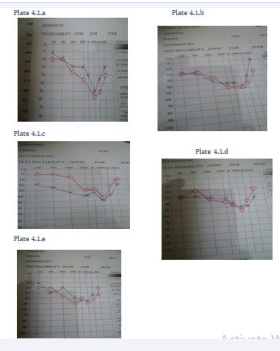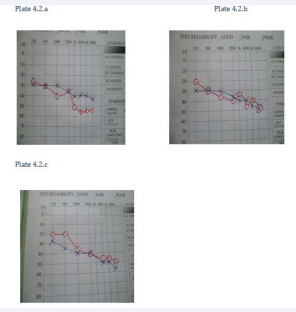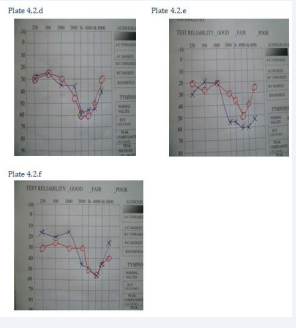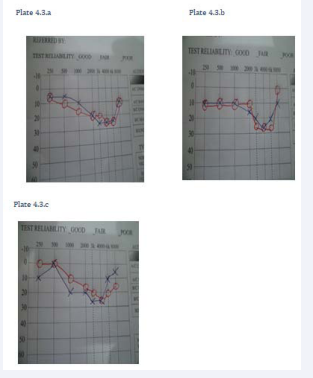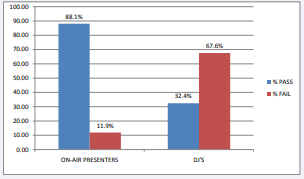Ear or Headphones as a Risk Factor to Aural Health of Disk Jockeys and On-Air Presenters in Kumasi Ghana
- 1. Department of Eye, Ear, Nose and Throat (EENT), Komfo-Anokye Teaching Hospital, Ghana
- 2. Ear, Nose and Throat Nursing Training School, Komfo-Anokye Teaching Hospital, Ghana
- 3. Department of Special Education, University of Cape Coast, Ghana
- 4. School of Public Health, Kwame Nkrumah University of Science and Technology (KNUST), Ghana
Abstract
The frequent use of ear/headphones among disk jockeys and on-air presenters has been thought to cause ear health problems and contribute to hearing loss in most low resourced regions globally. This study, examined one hundred and forty-five (145), DJ‘s and one hundred and forty-three (143) On-air presenters, two hundred and eighty-eight (288), subjects in all, from various radio and TV stations in the Kumasi metropolis in the Ashanti region of Ghana. The purpose of this study was to investigate the aural health disk jockeys and on-air presenters in the Kumasi metropolis of Ghana. A Qualitone Wide Range Type three audiometer used for a hearing screening test.
Of the 143 on-air presenters enrolled in the study, one hundred and twenty-six (126) (representing 88.1%) had normal hearing in both ears, thus between 0 to 25dB. The remaining seventeen (17), representing (11.9%), failed. And of the one hundred and forty-five (145), DJ‘s enrolled in the study, ninety-eight (98) (representing 67.6%) failed the screening test and the remaining forty-seven (47), (representing 32.4%) passed bilaterally.
In responds to a questionnaire, one hundred and sixty-four (164) (representing 57%), respondents reported frequent headaches, ear pain, intermittent tinnitus and the inability to hear very soft sounds immediately after using and taking off their ear/headphones, sixty-four (64) (representing 22.2%), reported itching and the remaining sixty (60) (representing 20.8%), had no complains.
In the end, there was an association between the frequent use of ear/headphones, hearing loss, (i.e. mild hearing loss, mild-moderate hearing loss, NIHLnoise induced hearing loss), intermittent tinnitus, ear pain, frequent headaches, itching and the inability to hear very soft sounds immediately after using and taking off ear/headphones.
Keywords
Ear/headphones; Disk Jockeys, On-air presenters; Otoscopy and audiometry; Screening tests
Citation
Saah NS, Mohammed ID, Dongyele M, Adu G, Nyadu O (2020) Ear/Headphones as a Risk Factor to Aural Health of Disk Jockeys and On-Air Presenters in Kumasi Ghana. J Ear Nose Throat Disord 5(1): 1042.
ABBREVIATIONS
DJ’s: Disk Jockeys; NIHL: Noise Induced Hearing Loss
INTRODUCTION
It has been thought that the frequent use of ear/headphones have resulted in many aural health problems. In general, hearing loss can be caused by factors like exposure to loud noise, aging (presbycusis), the intake of some medications, lifestyle, accidents, health conditions, hereditary factors and the frequent use of ear/ headphones (at high volumes and for too long) [1].
In most countries around the world today, the frequent use of ear/headphones at high volumes and for too long has become common especially among the youth. But this lifestyle comes with its own disadvantages, some of which include: temporary hearing loss, tinnitus, muffled hearing [2]. Anybody experiencing these symptoms would need to modify his/her listening habits right away to prevent further damage.
In Ghana, this trend has become so widespread that people of all ages can be seen using ear/headphones such as DJ`s and On-air presenters. DJ`s are radio presenters or broadcasters who usually play music on radio or at parties/dinners/ceremonies. On-air presenters are radio/TV presenters who present news, talk shows, commentaries, documentaries etc. Of the total two hundred and eighty-eight (288), subjects enrolled in the study, one hundred and seventy-eight (178), work seven (7), days a week, ninety-seven (97), work six (6) days a week and thirteen (13) work five (5) days a week using their ear/headphones while running shifts in between to allow their ears some time to relax.
The actual trouble is that MP3 players have the capability to blast 104 decibels (dB), directly into the ears which is equal to standing next to a pneumatic drill (110dB) (Ramsay, 2011). As a result, any level above 90dB over extended periods can cause long-term harm to one’s hearing. Consequently, persistent noise exposures equivalent to an average sound pressure level (SPL) of 85 dB (A) or more for eight-hours can result in permanent hearing loss [3]. In the same sense, four hours of noise exposure at 88 dB(A) will result in the same noise “dose” as eight hours at 85 dB(A). In line with some researches, headphones used by telephonists have been shown to create aural health problems [1].
Unfortunately, the effects of the frequent use of ear/ headphones at high volumes and for too long, are often overlooked because the damage takes place so slowly and do not present any externally-visible physical changes (like bleeding). In view of this fact, DJ’s and on-air presenters have traditionally not paid attention to its serious impact on their daily living until they are confronted by a lasting communication problem or progressive ringing in their ears [3], Maybe a bit too late, they then become passionate about hearing conservation in order to keep the hearing they still have. Hence, it does make more sense to put emphasis on hearing loss prevention, while one still has good hearing sensitivity. It is therefore in the interest of the employer and employee that a more detailed study is carried out to determine the effects of frequent ear/headphone use. The objective of this study was to assess the effects of the frequent use of ear/headphones among disk jockeys and on-air presenters in the Kumasi metropolis of Ghana.
MATERIALS AND METHODS
One hundred and forty-five (145), DJ’s and one hundred and forty-three (143), on-air presenters were selected from various radio and TV stations in the Kumasi metropolis, using multi-stage and simple random sampling. Their ages ranged from 20 to 60 years.
Informed consent was taken from participants after the nature and purpose of the procedure had been explained to them. The participants were then examined including otoscopy to detect foreign bodies, impacted wax, perforations of the eardrum, swellings, scaling in the canal, redness, lesions, cuts/ bruises and presence of other disorders of the ear. Audiometric Hearing Screening Assessment was done using Qualitone Wide Range Type three audiometer for respondents as in Table 1.
Table 1: Table showing the socio-demographic data of participants.
|
Socio-demographics |
Frequency, n=288 |
Percentage (%) |
|
Sex |
|
|
|
Male |
230 |
79.9 |
|
Female |
58 |
20.1 |
|
Age |
|
|
|
20-30years |
78 |
27.1 |
|
31-40years |
143 |
49.7 |
|
41-50years |
58 |
20.1 |
|
51-60years |
9 |
3.1 |
|
Educational status |
|
|
|
J.H.S (DJ’s) |
13 |
4.5 |
|
S.H.S (DJ’s) |
125 |
43.4 |
|
Tertiary (DJ’s /OAP) |
150 |
52.1 |
|
Marital status |
|
|
|
married |
193 |
67 |
|
single |
91 |
31.6 |
|
divorced |
4 |
1.4 |
|
Occupation |
|
|
|
DJ’s |
145 |
50.3 |
|
On-air presenters |
143 |
49.7 |
|
Gender and occupation |
|
|
|
Male DJ’s |
143 |
49.7 |
|
Male On-air presenters |
87 |
30.2 |
|
Female DJ’s |
2 |
0.69 |
|
Female On-air presenters |
56 |
19.4 |
|
Abbreviations: JHS: Junior High School; SHS: Senior High Secondary; DJ’s: Disk Jockeys; OAP: On-Air Presenters |
||
The table shows the intensity in dB and degrees of hearing loss used at Komfo Anokye Teaching Hospital (KATH). These same levels were used by the researcher for the hearing screening test conducted on the study participants in the current study.
The nature or degree of hearing reveals that one may have normal hearing (thus between the range of -10 to 25 dB HL), mild hearing loss (between the range of 26 to 40 dB HL), moderate hearing loss (between the range of 41to 55 dB HL), moderatesevere hearing loss (between the range of 56 to 70 dB HL), severe hearing loss (between the range of 71 to 90dB HL) or profound hearing loss (thus 90 dB HL and above), as shown in table 4.6.
To pass the test implies hearing the test stimuli/tone and responding appropriately between -10 to 25dB at all frequencies. And to fail he test implies not hearing the test stimuli/tone at 25dB at any of the test frequencies.
Individual results were plotted on different audiograms, which indicated the hearing thresholds in decibels (dB HL) against frequency in hertz (Hz) and analyzed.
Logistic regression analysis was used to characterize relationships between the data obtained from DJ’s and on-air presenters. Frequency distribution tables, bar graphs, figures and percentages were also used to analyze the responses where necessary.
Figure 1: An audiogram of a participant with NIHL.
Figure 2: Audiograms showing mild to moderate losses.
Figure 3: Audiograms showing NIHL.
Figure 4: Striking and Salient Observation made by Researcher.
Figure 5: Results of DJ’s and On- air presenters who either passed or failed the test.
RESULTS
A total of two hundred and eighty-eight (288) DJ’s and on-air presenters were screened from various radio and TV stations in the Kumasi metropolis in the Ashanti region of Ghana. Out of this number males were highly represented (79.9%) as compared to females (20.1). One hundred and forty five (145) were DJs and On-air presenters as shown in Table 2. From the regression analysis, DJ’s have reduced odds/chances of passing the hearing assessment test compared to the On-air presenters and the p-value is significant (Table 2).
Table 2: Logistic Regression Analysis for Occupational Distribution of Respondents.
|
Occupation |
Number Sampled |
Odds Ratio |
95% CI |
P-Value |
|
DJ’s |
145 |
0.069 |
0.038-0.127 |
?0.0001 |
|
On-air presenters |
143 |
Reference |
|
|
Of the 143 on-air presenters enrolled in the study, one hundred and twenty-six (126) (representing 43.8%) had normal hearing in both ears, thus between 0 to 25dB. Twelve (12) (representing 4.2%), out of the remaining seventeen (17), had their hearing levels between 30 and 45dB HL. These people had mild moderate hearing loss unilaterally and were therefore referred for further assessment and management at KATH. The last five (5) (representing 1.7%), subjects had what looked like NIHL, with losses at the higher frequencies and a recovery at 8K Hz (audiograms are shown below in plate 4.1.a, 4.1.b, 4.1.c, 4.1.d and 4.1.e) in both ears. In conclusion, out of the one hundred and forty-three (143), on-air presenters, one hundred and twentysix (126) (representing 43.8%), passed bilaterally (thus, in both ears), five (5) (representing 1.7%) out of the seventeen (17), failed bilaterally and twelve (12) (representing 4.2%) failed unilaterally (thus in only one ear).
Among the one hundred and forty-five (145) DJ’s enrolled in the study, ninety-eight (98) (representing 67.6%), failed the screening test and the remaining forty-seven (47) (representing 32.4%), passed bilaterally. Of the ninety-eight (98) who failed, sixty-four (64) (representing 65.3%), had NIHL and the remaining thirty-four (34) (representing 34.7%) had normal or mild to moderate losses in mainly one ear as shown in audiograms; Plate 4.2.a, Plate 4.2.b, Plate 4.2.c. This they said was the case because they would usually wear their headphones on just one ear and free the other ear. So in some cases, the study participants could tell which ear was the better one and which ear was not. In any case, the other ear failed too.
A striking and salient observation made by the researcher which indicates that even though a larger number of the study participants passed the test, (173 representing 60.1%), they might still be at risk of some hearing loss in the near future as shown in Plate 4.3.a, Plate 4.3.b, Plate 4.3.c.
DISCUSSION
From the study, DJ‘s have a reduced odds (0.069), of passing the test, thus, higher odds/chances of failing compared to the Onair presenters, indicating that DJ‘s are more prone to failing the hearing assessment test compared to On-air presenters.
One hundred and twenty-six (126), out of one hundred and forty-three (143), On-air presenters passed the hearing assessment test bilaterally (in both ears). The remaining seventeen (17) failed, having mild to mild-moderate and noise induced hearing loss (NIHL). These people were referred to KATH for further assessment and management. Invariably, twelve (12), out of this seventeen (17), had mild to mild-moderate hearing loss, thus, between 30 and 45dB HL unilaterally. The last five (5), subjects had NIHL in both ears, with losses at the higher frequencies and a recovery at 8K Hz. Ninety-eight (98), out of the one hundred and forty-five (145), Disk Jockeys enrolled in the study failed the hearing assessment test bilaterally. Of this number, sixty-four (64), had NIHL. Hence NIHL was prevalent among this group.
The study shows that, disk jockeys are more at risk of hearing loss because of the amount of noise they are exposed to. The finding is similar to that of Bray et al., who explored the noise exposure and hearing loss in twenty-three (23), DJ‘s and concluded that DJ‘s are at substantial risk of NIHL. While ninetyeight (98), out of the one hundred and forty-five (145), DJ‘s failed, forty-seven (47) passed bilaterally. Interestingly these fortyseven (47), have had exposures, equal to or more than some of the participants who exhibited NIHL. It may appear, these people have a natural resilience to loud noise.
A total number of two hundred and twenty-eight (228), out of the two hundred and eighty-eight (288), respondents reported headaches, ear pain, intermittent tinnitus, inability to hear very soft sounds immediately after using and taking off the ear/ headphones and itching, in responds to a questionnaire. Hence this study records the above as perceived effects of the frequent use of ear/headphones among DJ‘s and on-air presenters. This is in line with a study by Ansari and Mohammadpoorasl, 2016 who reported various complications (e.g. ear pain, tinnitus etc) of frequently using earphones especially among adolescents and young adults [4]. It is as well in line with a music television website research, which revealed that 32% of two thousand five hundred (2,500) random responses to the website reported symptoms of hearing loss, ear pain and tinnitus [5].
As mentioned earlier, one hundred and seventy-three (173), participants passed the audiometric and otoscopic tests and one hundred and fifteen (115), failed respectively. Out of the one hundred and seventy-three (173) who passed, seventy-nine (79, almost half the number) had their audiograms looking like that of NIHL. Even though these audiograms are in the normal range thus between -10 to 25dB HL they appear to have their higher frequencies falling. And if they continue in that trajectory, they will most probably develop NIHL, which this is alarming.
CONCLUSION
In conclusion, this study shows that, the frequent use of ear/ headphones puts DJ’s and On-air presenters at risk of noiseinduced hearing loss, ear pain, tinnitus, inability to hear soft sounds and headaches. Even so, DJ’s are at a more substantial risk of acquiring the aforementioned effects.
In recommendations, Disk Jockeys and On-air presenters can transform their lifestyles by simply reducing the volumes of their ear/headphones to the barest minimum. This practice should be made a routine to prevent aural health problems like NIHL, ear pain, tinnitus. Furthermore, they should have sessions in between listening times to allow the ear to recover. They should also take to regular ear checkups, since their carrier depends on sound hearing health. This group of professionals should also try to make time to learn/read to broaden their knowledge about the ear and its related issues. From the results, it is obvious that a potential problem is in the making, hence it is imperative that health care professionals begin to educate the people on the potential dangers of the frequent use of ear/headphones for too long and too loud.
Employers should ensure that, DJ‘s and On-air presenters have an ear examination prior to employment, so that a more detailed study can be done to establish or dismiss the association between the frequent use of ear/headphones and aural hygiene problems or hearing loss. These examinations should then be done yearly during employment, thus, employers must provide annual hearing tests for their employees, (DJ‘s and On-air presenters) to identify and make out any change in hearing that might point towards under- protection from the noise. Doing this will help avoid an overreaction from the employee if they develop any hearing related problems.
It is also very useful for employers to recommend or advocate regular washing or cleaning of the ear/headphones in accordance with the manufacturer‘s instructions, to prevent a pile up of bacteria or fungi that can cause aural health problems, gradually leading to hearing losses.
ACKNOWLEDGEMENTS
We are grateful to the management of the audiology center of the Komfo Anokye Teaching Hospital.
REFERENCES
- Mazlan R, Saim L, Thomas A, Said R, Liyab B. Ear infection and hearing loss amongst headphone users. Malays J Med Sci. 2002; 9: 17-22.
- Hodgetts WE, Rieger JM, Szarko RA. The effects of listening environment and earphone style on preferred listening levels of normal hearing adults using an MP3 player. Ear Hear. 2007; 28: 290- 297.
- Levey S, Fligor BJ, Ginocchi C, Kagimbi L. The Effects of Noise-Induced Hearing Loss on Children and Young Adults. Contemporary issues in Communication science and disorders. 2012; 39: 76-83.
- Ansari H, Mohammadpoorasl A. Using Earphone and its Complications: An Increasing Pattern in Adolescents and Young Adults. Heal Scope. 2016; 5.
- Quintanilla-Dieck M, Artunduaga MA, Eavey R. Intentional Exposure to Loud Music: The Second MTV.com Survey Reveals an Opportunity to Educate. J Pediatr. 2009; 155: 550-555.
